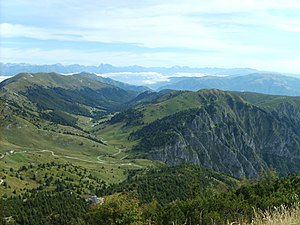First Battle of Monte Grappa
| First Battle of Monte Grappa (1917) | |||||||
|---|---|---|---|---|---|---|---|
| Part of the Italian Front of the First World War | |||||||
 View from the summit towards the Austrian positions |
|||||||
|
|||||||
| Belligerents | |||||||
|
|
|
||||||
| Commanders and leaders | |||||||
|
|
|
||||||
| Strength | |||||||
| 120,000 | 51,000 | ||||||
| Casualties and losses | |||||||
| 21,000 | 12,000 | ||||||
The First Battle of Monte Grappa, also known as First Battle of the Piave in Italy, was a battle fought during World War I between the armies of the Austro-Hungarian Empire and the Kingdom of Italy for control of the Monte Grappa massif, which covered the left flank of the new Italian Piave front.
The Italian Army was in all-out retreat after the Austrian autumn offensive of 1917. The Italian Chief of the general staff general Luigi Cadorna had ordered to construct fortified defenses around the Monte Grappa summit to make the mountain range an impregnable fortress. When the Austrian offensive routed the Italians, the new Italian chief of staff, Armando Diaz ordered the Fourth Army to stop their retreat and defend these positions between the Roncone and Tomatico mountains.
The Austrians, with help from the German Army's Alpenkorps, failed to take the mountains summit during the first battle of Monte Grappa from November 11, 1917 to December 23, 1917. The German and Austro-Hungarian supply lines had in fact become overstreched and Armando Diaz sent remnants of the defeated Second Army in support of the Fourth Army. He also allowed his local commanders much more room for manoeuvre than his predecessor, which resulted in a more elastic and effective Italian defense.
Thus the Italian front along the Piave river was stabilized and the Austrians failed to enter the plains beyond and take the city of Venice.
Coordinates: 45°51′N 11°44′E / 45.850°N 11.733°E
...
Wikipedia
